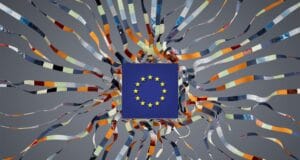On July 5th, the Data Spaces Interoperability Compass (DSIC) team organised an interactive session on data spaces interoperability: challenges and value potential in practice. The session aimed to uncover interoperability challenges and value potential of federating data spaces in practice, but also what this means for the development of your data sharing initiative.
Presentations on interoperability
Yekaterina Travkina (CoE-DSC) talked about uncovering the value of cross-domain data sharing and interoperability. According to her, the next step in the development of data spaces is realising cross-domain data sharing, which requires practical navigation. Yekaterina showed two examples in practice of data sharing initiatives realising value from cross-domain data sharing by federating: the automotive & steel manufacturing work together to strengthen resilience of supply chains (Catena-X and SCSN), and energy & finance work together to offer green loans (EDSN and HDN). But a part of federating is aligning building blocks of the involved initiatives.
Afterwards, Harrie Bastiaansen (CoE-DSC) covered recent EU developments on interlinking layer for federating data spaces. His key take-aways are:
- To achieve large scale federation, an agreed upon approach on the key capabilities discoverability, trust and data sovereignty is needed.
- Large-scale federation, with many cross-cutting use cases, needs a structural interoperability approach when many data sharing initiatives are involved. Building federations between data space instances in a multi or bilateral manner is not expected to be scalable for such situations.
- The EC is developing a structural interoperability approach, which may need to be taken into account for data sharing initiatives when (large scale) federation and interoperability with EU data sharing initiatives is foreseen.
- Gradual migration/evolution scenarios for existing data sharing initiatives towards (large scale) federation and interoperability should be developed, without requiring major solution replacements or upgrades.
Panel discussion
During a panel discussion, we explored interoperability with representatives from Dutch data sharing initiatives. Our guests were:
- Maryse Bücking from NTM, actively involved in European Mobility Data Space (EMDS) developments through EDIC.
- Niels Bolding from Health RI, building bridges between data for primary and secondary use, and international healthcare data sharing.
- Edwin van den Belt, from Goudappel active in DRO and Shared mobility use cases, international MaaS environments. A member of the Transmodel and CoRoM working groups (standardisation at European level).
- Rik de Lange, on behalf of RVO involved in the DVU (Datastelsel Verduurzaming Utiliteit), focused on the interoperable exchange of the energy data from non-residential buildings in the Netherlands in collaboration with iSHARE.
These are their key-takeaways:
Maryse Bücking: “We’re working hard in the Netherlands and there are already some great initiatives. Everyone agrees that semantic interoperability is an important factor to achieve cross-sectoral data sharing, but we can’t do it in isolation. We need to do this cross-border, and we need input from the business perspective to start implementing the relevant use cases. That way we can work on the dictionary using real examples, for objects that are highly relevant for cross-sector data sharing.”
Niels Bolding: “The relationship between data availability and AI is symbiotic: AI development relies heavily on the accessibility of comprehensive data, while AI technologies can significantly enhance data availability. Prioritising the secondary use of health data is crucial for advancing both AI capabilities and healthcare outcomes. Let’s elevate this to the top of our agendas!”
Edwin van den Belt: “There is a need for (integrated) data flows, we have to align to prevent that we stay on ‘data islands’.”
Rik de Lange: “Data is a verifiable source of information and should be able to flow freely to where it is needed. The need for data is community driven: public or private. Use cases should give directions to what is needed.”
Download slidedeck
Interactive session
After the panel discussion, we had an interactive part involving our audience in Mentimeter discussions, including those who joined online as well. As a result, we gathered that ensuring interoperability of soft infrastructure (that is governance, legal and business building blocks) is deemed to be more challenging compared to hard infrastructure. Semantic interoperability stood out as a topic requiring attention and being on top of minds. As for the actions, data sharing initiatives already take steps to explore and engage with the topic and not just waiting for the EU. The steps parties take include:
- Exploring together with close partners
- Forming alliances within a sector
- Joining different EU tables such as EDIC
In this light, intersting insight came from healthcare. In the Netherlands a healthcare sector started a so called “obstakel verwijder traject” (obstacle removal trajectory) to identify and remove 18 major obstacles to data sharing. This could be an interesting approach to explore also for other sectors.
Do you want to learn more or join us? Please find here more information about DSIC or send an email to: [email protected]




